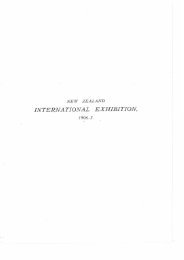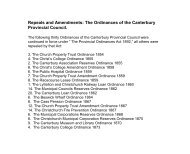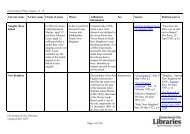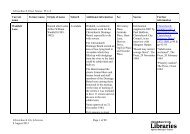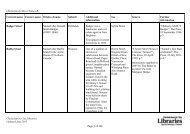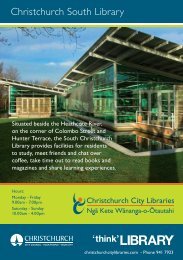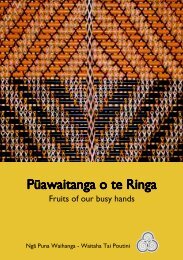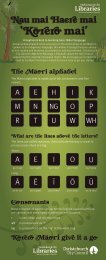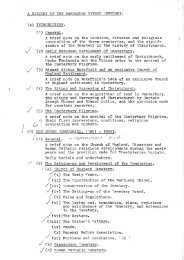Conservation Plan Addington Cemetery - Christchurch City Libraries
Conservation Plan Addington Cemetery - Christchurch City Libraries
Conservation Plan Addington Cemetery - Christchurch City Libraries
Create successful ePaper yourself
Turn your PDF publications into a flip-book with our unique Google optimized e-Paper software.
3.1.2 <strong>Christchurch</strong> <strong>City</strong> Council Heritage Listing Criteria<br />
Historical and Social Significance<br />
<strong>Conservation</strong> <strong>Plan</strong> for <strong>Addington</strong> <strong>Cemetery</strong><br />
<strong>Addington</strong> <strong>Cemetery</strong>, established in December 1858, is the third oldest European cemetery<br />
in <strong>Christchurch</strong>, after Barbadoes Street <strong>Cemetery</strong> (1845) and Woolston <strong>Cemetery</strong> (1852). 41<br />
The cemetery is a historical record of the many members of the local <strong>Christchurch</strong><br />
community. The memorials contained within it help to document <strong>Christchurch</strong>’s growth,<br />
and they assist in documenting the life of a range of ‘European’ New Zealanders.<br />
The layout of the cemetery is comparable to Sydenham <strong>Cemetery</strong> in <strong>Christchurch</strong>. These<br />
two cemeteries appear more structured than many other Victorian Cemeteries which tend<br />
to include a more spacious, rambling appearance. Part of the significance of <strong>Addington</strong><br />
<strong>Cemetery</strong> is its closely spaced grid layout, with its tightly packed and relatively small plots<br />
(at<br />
<strong>Addington</strong> they are mostly 9 feet by 3 feet, whereas at other cemeteries in <strong>Christchurch</strong><br />
the plots tend to be slightly larger at 9 feet by 4 feet), and narrow paths: this reflects the<br />
requirements of the church group who established the cemetery to create the maximum<br />
amount of saleable land for burials within a restricted<br />
space. There is no obvious<br />
segregation of burials according to religion at <strong>Addington</strong> <strong>Cemetery</strong>, compared to some<br />
other cemeteries such as Waimari<br />
<strong>Cemetery</strong> in <strong>Christchurch</strong> where there are separate<br />
sections for Anglican, Roman Catholic,<br />
Methodist, Presbyterian burials and at Linwood<br />
<strong>Cemetery</strong> in <strong>Christchurch</strong> were there is a section for Jewish burials within the wider<br />
cemetery.<br />
Although established by the Presbyterian Church, <strong>Addington</strong> <strong>Cemetery</strong> was the first truly<br />
public cemetery to be established in <strong>Christchurch</strong><br />
as made clear by the original newspaper<br />
advertisement for the cemetery in the Lyttelton Times in December 1858. It is a resting<br />
place of not only some notable New Zealanders of the 19 th and early 20 th centuries, but of<br />
ordinary citizens of <strong>Christchurch</strong>. Included in the notable early pioneer families buried in<br />
the cemetery are the Deans family of Riccarton, suffragist Kate Sheppard, politician Tommy<br />
Taylor, artist John Gibb and architect Samuel Farr.<br />
Cultural / Spiritual Significance<br />
<strong>Addington</strong> <strong>Cemetery</strong> encompasses religious, spiritual, traditional, cultural as well as<br />
education associations and is valued by the immediate and wider community for all of<br />
41 There are urupa (Maori burial grounds) in the wider <strong>Christchurch</strong> area that pre-date the colonial<br />
cemeteries.<br />
44



